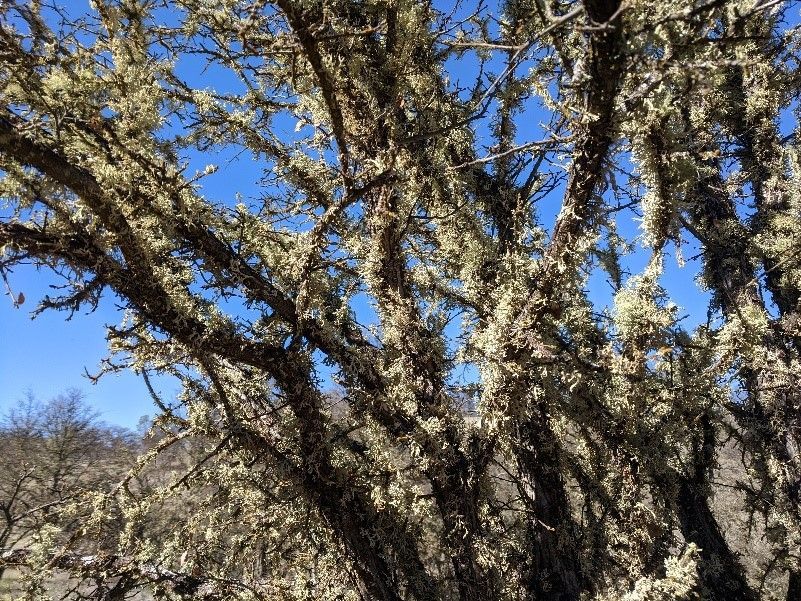Tuleyome's Science Corner - Lichen

Oak Moss Lichen on a tree near the Dunfield Spring Trail in Berryessa Snow Mountain National Monument. Photo by Geoff Benn
The Berryessa Snow Mountain National Monument is home to a wide variety of lichens, ranging in appearance from drab flattened circles on rocks to wild filamentous and spiky forms that festoon trees. Among the latter category is our newly minted state lichen, the Lace Lichen, which can be seen in great numbers dangling from the branches of oak trees along Highway 128 south of Lake Berryessa.
So, what are lichens anyway? They’re actually not a single organism but are instead a long-term symbiosis between two different species – a fungal partner and a photosynthetic partner, which can be either a green alga or a cyanobacteria. Most of the body of a lichen is comprised of fungal filaments called hyphae, with a thin layer containing the photosynthetic partner just underneath the upper surface. The hyphae of the fungi wrap tightly around the individual cells of the photosynthetic partner, enabling the transfer of materials between the two species. There is still some debate about the exact nature of the relationship between the two partners, but the most commonly held view is that it is a mutualistic association where the photosynthetic partner provides sugars to the fungi and receives a protected place to live in return.
There are over 1900 species of lichen in California, with each adapted for growing on different types of surfaces, including species that specialize on desert soil, newly exposed rock, or living on trees. Lichens excel at living in these challenging environments because they can dry out almost completely and then revive once moisture returns. In fact, researchers with the European Space Agency exposed lichens to the vacuum of space for 14 days and found that they grew normally afterwards.
Lichens play an important role in the weathering of rocks by secreting chemicals that slowly break down the rocks, contributing to the formation of new soil. These rock dwelling lichens tend to be extremely slow-growing species that may grow at rates of only 1-2mm per year. Scientists have taken advantage of this fact by developing the field of lichenometry, which uses the growth rates of lichens to estimate the age at which a rock was first exposed to the surface. These techniques are particularly useful for dating surfaces that are 500 years or younger, where radiocarbon dating tends to be less effective.

Several species of lichen on a tree on the Fiske Peak Trail in Berryessa Snow Mountain National Monument. Photo by Geoff Benn
In addition to rock-dwelling lichens, species that grow on trees are very common in the Berryessa Snow Mountain National Monument. One of the most common is the Oak Moss Lichen, which I frequently see on Blue Oaks in the area. Unlike the parasitic mistletoes that also grow on oaks, lichens don’t harm the trees and only use them as a surface to grow on. Lichens may be more prevalent on dead or dying trees – this is likely due to the increased availability of sunlight due to the lack of leaves on the tree.
Lichens are also an important indicator of air quality. This is because they must absorb their nutrients from the air and are thus particularly sensitive to air pollution. This sensitivity is one reason why lichens tend to be uncommon in urban areas.
If you’ve been lichen this article, you can learn more about lichens in the Berryessa Snow Mountain National Monument by visiting iNaturalist.
-Dr. Geoff Benn (gbenn@tuleyome.org)
Education Associate
RECENT ARTICLES






